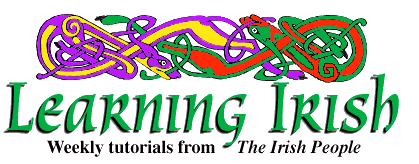
Irish Lesson 29
|
Pronunciation review The letter "r" is pronounced with two principal sounds in Irish, and both sounds differ from the American pronunciation. If the "r" begins a word and is followed by an "a, o, u", roll the sound by placing the tongue tip near enough to the hard ridge behind the upper front teeth to make the tongue vibrate as you say the "r". Examples: rás, ramhar (ROU-wuhr), raca (RAHK-uh), ród, roc (rohk), rún (roon), rud (ruhd). Give "r" the same sound when it begins a word and is followed by "e, i", as in: réim (ray*m), reilig (REL-ig), rí (ree), riamh (reev), rith (ri). The broad "r" sound inside a word or at the end, and near "a, o, u", is not as likely to be rolled. It often resembles the American pronunciation. A double "r" near "a, o, u", is rolled, however, as in: barr (bahr), cearr (kyahr), carraig (KAHR-rig), bearraim (BYAHR-rim), borradh (BOHR-ruh). Next to an "e, i" inside or at the end of a word, the "r" gets its slender sound. This is perhaps the most difficult Irish sound for Americans. Place the tongue tip near the top of your upper front teeth and form a shallow pocket in the tongue front. Then pronounce "r". The air should blow downwards toward the lower lip as you drop the tongue. Try: fir (fir), beirim (BER-im), litir, féir (fay*r), Máire (MAW*-re), creid (kred), Bríd (breed). Compare "féar" with "féir". The former word has an "r" like the American "r" at its end. The slender "r" faintly resembles a "d" or "zh" sound in English. In parts of Ireland, a word like "Máire" may sound like (MAW*-zhe). Slender "r" after a consonant sometimes seems to add a syllable, as in: breá (bir-RAW*). In Irish, "r" is pronounced in the front of the mouth, never in the back with a guttural rolling as in some other European languages. Grammar Up to now, all the verbs that you have studied, with one exception, have been "regular". In a regular verb, the forms are based on the imperative, which you can always recognize in the verb form. For instance, "cuir" (kir) means "Put!" In the past tense, "chuir sé" (k*ir shay*) means "he put". "Chuireann (KIR-uhn) sé" means "he puts", and "chuirfinn" (K*IR-hin) means "I would put". All forms are easily recognizable as belonging to "cuir". The irregular verbs change more in going from tense to tense, and some change going from affirmative to negative. One irregular verb is "tá". It becomes "níl" and "an bhfuil" in the present, and then changes to "bhí", "ní raibh", and "an raibh" in the past. About ten other Irish verbs are irregular, many fewer than in English, but the Irish verbs change more. We will learn them gradually. The first two are "come" and "go", in the past tense.
"Came" is:
níor tháinig mé, I didn't come
ar tháinig mé?, did I come?
nár tháinig mé?, didn't I come?
"Went" is:
ní dheachaigh mé (nee YAK*-hee may*), I didn't go
an ndeachaigh mé? (un NYAK*-hee may*), did I go?
nach ndeachaigh mé? (nahk* NYAK*-hee may*), didn't I go? Remember that the "ch" next to an "a, o, u" is pronounced by dropping the back of the tongue somewhat while you pronounce the "c" that is in "coat". The result is a guttural sound like that in the German "ach". Don't drop the tongue so far that all you get is an "h" sound. Our phonetic guide employs (k*) for the sound. Drill Go through a progressive drill with each of these two verbs. Start with: Ar tháinig mé? Níor tháinig mé. Tháinig tú. Ar tháinig tú? Níor tháinig tú. Tháinig sé. Continue to the last phrase: Tháinig mé. "Went" requires some alertness. Start with: An ndeachaigh mé? Ní dheachaigh mé. Chuaigh tú. An ndeachaigh tú? Ní dheachaigh tú. Chuaigh sé. Continue to the last phrase: Chuaigh mé. Then join the following phrases to all forms to make sentences: amach; isteach; suas an staighre; síos an staighre; amach sa ghairdín; isteach sa teach; inné; abhaile; inniu. Remember that "I was going" is "Bhí mé ag dúl", and that "I was coming" is "Bhí mé ag teacht". "I went" and "I came" are this lesson's subject. (c) 1997 The Irish People. May be reprinted with credit. |